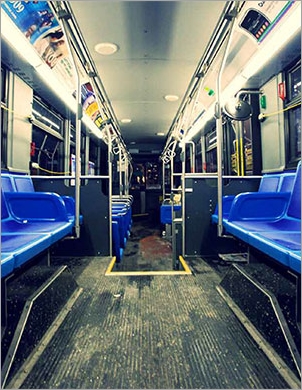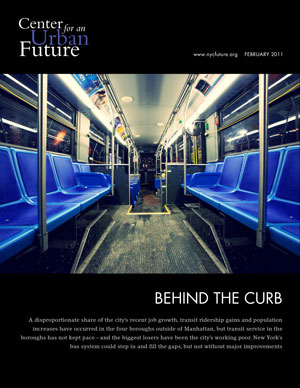Good morning. My name is David Giles. I’m the research director at the Center for an Urban Future, a New York City-based public policy think tank specializing in economic and workforce development. Thank you for inviting me to this important event.
In a 2011 transportation study called Behind the Curb, the Center for an Urban Future called attention to New York City’s rapidly changing economic geography. Over the last four decades the boroughs outside of Manhattan have been steadily gaining in their share of the city’s jobs, and over the last decade every one of them outstripped Manhattan in the total number of jobs grown. Growth in the city’s health care and education sectors, we showed, have been driving a lot of the city’s new jobs over the last ten years, and unlike many other traditional NYC industries these new jobs are not concentrated in the Manhattan CBDs but spread out in the boroughs. Hard as it is to believe, outer borough job centers like East Flatbush and Sunset Park in Brooklyn, Morris Park and Hunts Point in the Bronx, and JFK and Flushing in Queens are gaining on Midtown and Downtown Manhattan in their share of jobs.
This is having a profound effect on commute patterns.
In 1980, a majority of outer borough workers commuted to Manhattan for work every day. Today, a majority travel inside their own borough, and more than ever are traveling to another outer borough or adjacent county. For example, in our 2011 report, we found enormous increases in the number of commuters traveling from Staten Island to Brooklyn and New Jersey, and from the Bronx to Westchester County, and from Brooklyn to Queens, while in each one of these cases the percentage increase for commuters traveling to Manhattan was much smaller (in Staten Island there was little to no growth at all in nearly 20 years).
What’s more, as former industrial areas in Sunset Park, Long Island City and downtown Brooklyn, among other places, continue to transform into office districts for tech and creative companies, non-Manhattan commuting is liable to become the norm for an increasing number of New York City residents.
Addressing this challenge should be a top priority for the MTA over the next ten years and beyond.
I’d like to make several ambitious proposals that, I think, would do just that:
1. Continue to Invest in New York City’s Bus System.
-
Increase the number of Select Bus Service (SBS) lines and reduce the time it takes to implement these routes. The current 5-year implementation process is too long.
-
Consider implementing elements of SBS on all city buses. In our 2011 report, we recommended that GPS devices be installed on all city buses rather than just SBS buses, and the MTA is now doing that. The next step is to look at implementing Proof of Payment on all city buses. More than anything else, this has the potential to revolutionize bus service in New York City.
2. Study Regional Rail Integration and Publish the Results.
-
You can’t talk about expanding the transit system in New York City without considering how we could use what we have more efficiently. The LIRR, Metro North and even NJ Transit could serve many more customers and dramatically transform the city’s public transit system if we started through-running trains at Penn Station, increased the frequency of service, and reduced fares inside the city limits. Hundreds of thousands of commuters in Queens and the Bronx, in particular, would get rapid transit service for the first time, and commuters all over the region would gain direct access to job centers outside of the CBD without adding to the congestion in Midtown Manhattan. Flushing, Jamaica, Long Island City, and Downtown Brooklyn—among other growing economic centers—would gain new rapid transit lines for the first time in generations, and these new lines would not only help alleviate long commutes but spur development in areas that could benefit from it.
-
If it chooses to, the MTA can model several versions of this proposal and publish the costs and the benefits.
3. Link Transportation Planning with Broader Economic Development Goals.
-
The MTA and its subsidiaries need to look beyond agency priorities to become a planning and development partner with state and city economic development agencies.
-
The MTA should partner with the Department of City Planning, the Department of Transportation and the city and state Economic Development Corporations on transit oriented-development. SBS lines, for instance, should be paired with upzonings and other development initiatives to encourage development along new lines. The proposed Woodhaven Blvd line would be a good place to start this process.
-
The MTA should also consider development opportunities on the properties it owns, starting with the Sunnyside Yards in Western Queens. As a part of the East Side Access project, the LIRR has proposed a new multi-billion dollar mid-day storage facility for Grand Central bound trains on so-called Yard A. Yard A is approximately 49 acres, and it’s located on the western side of the yards, contiguous with Queens Plaza. The MTA should revisit this proposal and consider whether developing the site without decking wouldn’t outweigh the costs of moving the storage facility further away from the CBD. Spending over a billion dollars on a train storage facility next to one of the fastest developing areas of the city would be a huge waste of resources and a wasted opportunity to raise revenue for transit.
-
Next, as a part of Penn Station Access, the MTA should invest in regional rail stations at the Ditmars N/Q stop in Astoria and on the Sunnyside Yards. As a part of a broader effort to better integrate regional rail service in the city’s rapid transit network, both stations would open up western Queens to commuters all over the region, while making it possible for residents of Queens to travel north to the Bronx, Westchester and Fairfield Counties without traveling through Penn Station. But even without full integration, having an intermodal station in LIC would be hugely beneficial both from a transportation planning and economic development perspective.
This testimony was presented on July 16, 2014.



